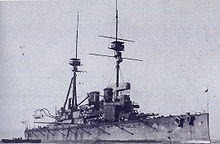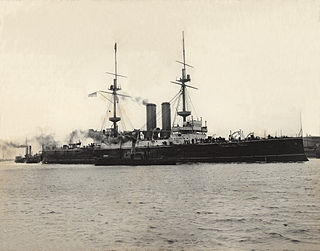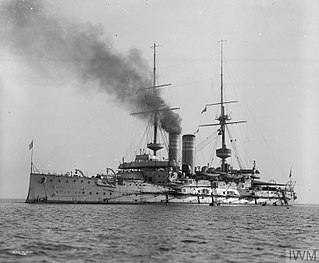| 6th Battle Squadron | |
|---|---|
| Active | 1913–1917 |
| Country | |
| Branch | |
| Type | Squadron |
The 6th Battle Squadron was a squadron of the British Royal Navy consisting of Battleships serving in the Grand Fleet and existed from 1913 to 1917.
| 6th Battle Squadron | |
|---|---|
| Active | 1913–1917 |
| Country | |
| Branch | |
| Type | Squadron |
The 6th Battle Squadron was a squadron of the British Royal Navy consisting of Battleships serving in the Grand Fleet and existed from 1913 to 1917.

In August 1914, the 6th Battle Squadron was based at Portland and comprised a number of the older pre-dreadnought battleships it was then assigned to the Second Fleet [1] these included:
HMS Lord Nelson and Agamemnon transferred to the 5th Battle Squadron in late 1914. HMS Revenge briefly joined the squadron in 1915, before the squadron was broken up. Most of the ships were sent to the Mediterranean.
On 13 November 1917, Rear Admiral Hugh Rodman broke his flag in USS New York as Commander, Battleship Division 9. After preparations for "distant service", USS Wyoming, New York, Delaware, and Florida sailed for the British Isles on 25 November and reached Scapa Flow, Orkney Islands, on 7 December 1917. Although retaining their American designation as Battleship Division 9, those four dreadnoughts became the Sixth Battle Squadron of the British Grand Fleet upon arrival in British waters. The 6th Battle Squadron operated from Scapa Flow and Rosyth.
The U.S. Battleships serving in the 6th Battle Squadron were:
Post holders as follows: [2] [3]
| Rank | Flag | Name | Term | Notes | |
|---|---|---|---|---|---|
| Vice/Rear-Admiral, Commanding, 6th Battle Squadron | |||||
| 1 | Vice-Admiral | | Sir Alexander Bethell | 15 July 1913 | as 6BS 2FL |
| 2 | Rear-Admiral | | Charles H. Dundas | 1913 - 20 December 1914 | as 6BS 2FL |
| 3 | Rear-Admiral | | Stuart Nicholson | 5 December 1913 - 12 April 1916 | as RADMHFSNORE |
| 4 | Rear Admiral | | Hugh Rodman | 13 November, - December, 1917 | BS DIV9 USN |
Note: RADMHFSNORE Rear-Admiral, Home Fleets at the Nore.

USS Delaware (BB-28) was a dreadnought battleship of the United States Navy, the lead ship of her class. She was laid down at Newport News Shipbuilding in November 1907, launched in January 1909, and completed in April 1910. The sixth ship to be named for the First State, Delaware was armed with a main battery of ten 12-inch (305 mm) guns all on the centerline, making her the most powerful battleship in the world at the time of her construction. She was also the first battleship of the US Navy to be capable of steaming at full speed for 24 continuous hours without suffering a breakdown.

The Grand Fleet was the main battlefleet of the Royal Navy during the First World War. It was established in August 1914 and disbanded in April 1919. Its main base was Scapa Flow in the Orkney Islands.

The Home Fleet was a fleet of the Royal Navy that operated from the United Kingdom's territorial waters from 1902 with intervals until 1967. In 1967, it was merged with the Mediterranean Fleet creating the new Western Fleet.
The 5th Battle Squadron was a squadron of the British Royal Navy consisting of battleships. The 5th Battle Squadron was initially part of the Royal Navy's Second Fleet. During the First World War, the Home Fleet was renamed the Grand Fleet.

The British Mediterranean Fleet, also known as the Mediterranean Station, was a formation of the Royal Navy. The Fleet was one of the most prestigious commands in the navy for the majority of its history, defending the vital sea link between the United Kingdom and the majority of the British Empire in the Eastern Hemisphere. The first Commander-in-Chief for the Mediterranean Fleet was the appointment of General at Sea Robert Blake in September 1654. The Fleet was in existence until 1967.

The Atlantic Fleet was a naval fleet of the Royal Navy. It existed for two separate periods; 1909 until 1914, and then 1919 until 1932.

The Channel Fleet and originally known as the Channel Squadron was the Royal Navy formation of warships that defended the waters of the English Channel from 1854 to 1909 and 1914 to 1915.
The 1st Battle Squadron was a naval squadron of the British Royal Navy consisting of battleships. The 1st Battle Squadron was initially part of the Royal Navy's Grand Fleet. After World War I the Grand Fleet was reverted to its original name, the Atlantic Fleet. The squadron changed composition often as ships were damaged, retired or transferred.
The 3rd Battle Squadron was a naval squadron of the British Royal Navy consisting of battleships and other vessels, active from at least 1914 to 1945. The 3rd Battle Squadron was initially part of the Royal Navy's Home Fleet. During the First World War, the Home Fleet was renamed the Grand Fleet. During the Second World War, the squadron covered Atlantic convoys.

The 4th Battle Squadron was a squadron of the British Royal Navy consisting of battleships. The 4th Battle Squadron was initially part of the Royal Navy's Home Fleet (1912–14) and then the Grand Fleet after the outbreak of the First World War. The squadron changed composition often as ships were damaged, retired or transferred.

The Battle Cruiser Fleet, (BCF), later known as Battle Cruiser Force, a naval formation of fast battlecruisers of the Royal Navy, operated from 1915 to 1919.
The Second Fleet was a reserve formation of the Royal Navy that briefly existed before the First World War.

The 7th Battle Squadron was a squadron of the British Royal Navy assembled prior to World War I it was assigned to the Third Fleet and consisted of pre-dreadnought type battleships the oldest ships in fleet it existed from 1912 to 1914.

The 8th Battle Squadron was a squadron of the British Royal Navy assembled prior to the beginning of World War I; it was later assigned to the Third Fleet. The squadron consisted of pre-dreadnought type battleships. It existed from 1912 to 1914.
The 2nd Division was a naval formation of the British Home Fleet it was formed before First World War in March 1909 until May 1912.

The 2nd Cruiser Squadron was a formation of cruisers of the British Royal Navy from 1904 to 1919 and from 1921 to 1941 and again from 1946 to 1952.

The 10th Cruiser Squadron, also known as Cruiser Force B was a formation of cruisers of the British Royal Navy from 1913 to 1917 and then again from 1940 to 1946.
The 1st Destroyer Flotilla, also styled as the First Destroyer Flotilla, was a naval formation of the British Royal Navy from 1909 to 1940 and again from 1947 to 1951.
The British 3rd Destroyer Flotilla, also styled as Third Destroyer Flotilla, was a naval formation of the Royal Navy from 1909 to 1939 and again from 1945 to 1951.

The Eastern Mediterranean Squadron later known as the British Aegean Squadron was a naval formation of the Mediterranean Fleet based at Mudros from 1914 to 1916. It then alternated between Mudros and Salonika from 1917 to 1919.